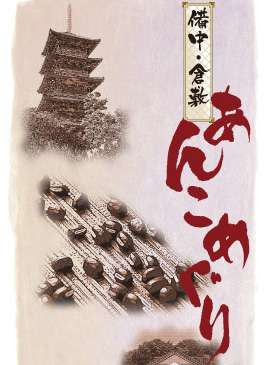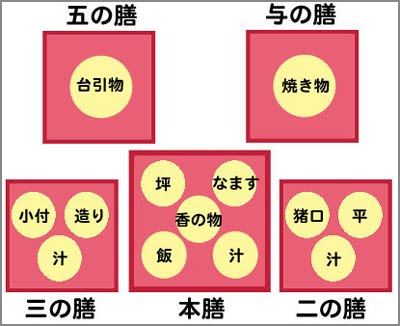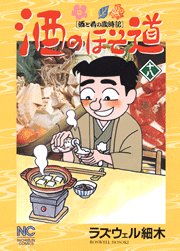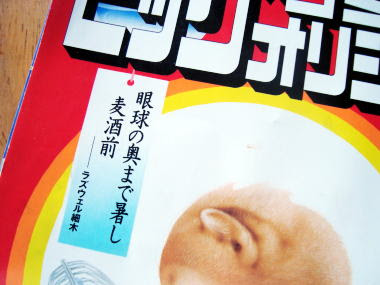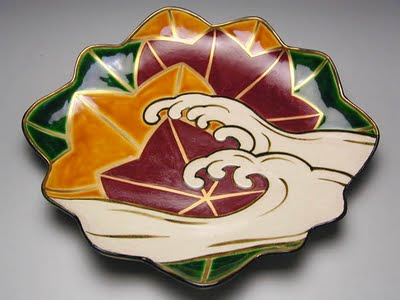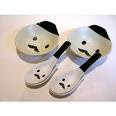[ . BACK to WORLDKIGO TOP . ]
::::::::::::::::::::::::::::::::::::::::::::::::::::::::::::::::::::::::::::::::::::::::::::::::::::
- 壬生寺
Mibu-Dera - see below -
Hooroku Jizo ほうろく地蔵
with an earthen pot on his head
焙烙地蔵
First let us look at the hooroku pot.
 hooroku 焙烙 / 炮烙 / ホーロク / ほうろく is a special earthen pot.
hooroku 焙烙 / 炮烙 / ホーロク / ほうろく is a special earthen pot.
Sometimes also called "hooraku, horaku".
It is used to roast tea leaves, beans, sesame seeds and other grains and even salt.
The origin of this word seems to be the word for the death penalty on the stake 炮烙. Grains are roasted slowly and the pan is moved constantly. This reminds the Japanese of the slow dance of Shizuka Gozen, which is called Hoorakumai 法楽舞(ほうらくまい).
In Kyoto, the pan is called
irigora いりごら(炒瓦), in Chiba (Shimofusa)
irigara いりがら.
irinabe 炒り鍋(なべ)roasting pan, is another word for this earthen pan.
Since it breaks easily there is an old proverb
A thousend hooro pans but only one hammer.
焙烙千に槌(つち)一つ
you can distroy 1000 pots easily with one hammer.
hooraku 宝楽 is a special flat pot to cook festival food like
tai sea bream and lobster.
hooroku 法烙 are flat plates used in temples.
roku ロク(慣)means to warm something (food or your hands for example) over the fire.
WASHOKU : hooroku dishes of various regions

In a
kyogen humorous story called
Hooraku wari 炮烙割り, it is pronounced
hooraku. See below for more.
hooroku 法烙 are flat plates used in temples.

During the ancestor festival O-Bon in August temples provide
hooroku that you can place on the graves and make a little fire in them to welcome the ancestors.
kawarake-nage かはらけなげ throwing dishes
at Mount Atago, Atago Shrine, Kyoto. かわらけ投げ
. The Atago shrines of Japan .
:::::::::::::::::::::::::::::::::::::::::::::::::::::::::::::::::::::::::::::::::::::::::::::::::::
Thanks to Mark, who got me started on this subject!
Hōroku Jizō ほうろく地蔵
Devotees offer earthenware plates to images of this Jizō when they suffer from headaches or other head ailments. They write their prayers on the earthenware, and present the plates to Jizō, or place it atop the statue's head.
Hōroku Jizō
Mark Schumacher and the Jizo Pages
:::::::::::::::::::::::::::::::::::::::::::::::::::::::::::::::::::::::::::::::::::::::::::::::::::
at Temple Dai-en-ji , Daienji 大円寺
東京都文京区, Tokyo, Bunkyo
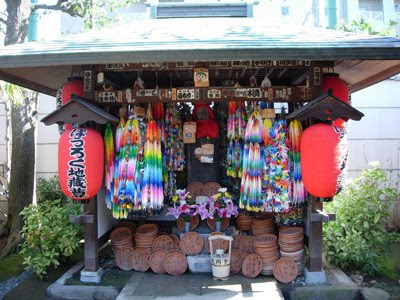 . . . CLICK here for Photos !
. . . CLICK here for Photos !
This temple reminds us of the love story of
Yaoya O-Shichi 八百屋お七 and the great fire of 1682 in Edo. She was later sentenced to death for causing this great fire.
To appease her soul, this Jizo statue was errected. Hot earthen plates (hooroo) were placed on the head of Jizo, to lighten the heat of hell fires for O-Shichi. The statue was offered by one Watanabe Kyuubei 渡辺九兵衛 in 1719.
Later this Jizo came to be healing headaches, eye and ear and nose diseases and other diseases of the head too.
 source : c-kitamura.cocolog-nifty.com
source : c-kitamura.cocolog-nifty.com
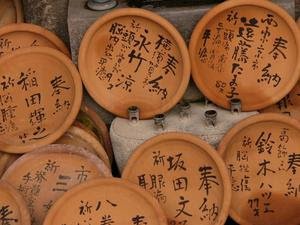 Hooroku plates with wishes
Hooroku plates with wishes
Daruma Museum
O-Shichi Kannon お七観音
:::::::::::::::::::::::::::::::::::::::::::::::::::::::::::::::::::::::::::::::::::::::::::::::::::::
Saitama, Kurihashi 栗橋
焙烙地蔵 (ほうろくじぞう)
This statue is at a site of executions by burning during the Edo period, for people who tried to get out of Edo without permission. This Jizo statue is to appease the souls.
. . . CLICK here for Photos !
:::::::::::::::::::::::::::::::::::::::::::::::::::::::::::::::::::::::::::::::::::::::::::::::::::::
at a site of a former shrine
上知我麻神社
near Tenmacho in Tokyo 伝馬町
 この石地蔵は、もと三河国重原村(現在知立市)にあったが、野原の中に倒れ、捨石のようになっていた。ところが、三河より焙烙(ほうろく)を売りに尾張へ来るものが、荷物の片方の重しとしてこの石仏を運んできて、ここで焙烙を売りつくした後、石仏を海辺のあし原に捨てて帰った。地元の人がこの石仏を発見し、安置しようとしたが、動かないので怪しんでその下を掘ってみると、土中にこの仏の台座と思われる角石が深く埋もれていたので、皆が不思議なことだと思い、その台石を掘り出し、この石仏を置いたのが、すなわちこの地蔵である。・・・
. . . CLICK here for Photos !
この石地蔵は、もと三河国重原村(現在知立市)にあったが、野原の中に倒れ、捨石のようになっていた。ところが、三河より焙烙(ほうろく)を売りに尾張へ来るものが、荷物の片方の重しとしてこの石仏を運んできて、ここで焙烙を売りつくした後、石仏を海辺のあし原に捨てて帰った。地元の人がこの石仏を発見し、安置しようとしたが、動かないので怪しんでその下を掘ってみると、土中にこの仏の台座と思われる角石が深く埋もれていたので、皆が不思議なことだと思い、その台石を掘り出し、この石仏を置いたのが、すなわちこの地蔵である。・・・
. . . CLICK here for Photos !
:::::::::::::::::::::::::::::::::::::::::::::::::::::::::::::::::::::::::::::::::::::::::::::::::::::
kigo for late summer
 hooroku plates for moxibustion ほうろく灸
hooroku plates for moxibustion ほうろく灸
hooroku kyuu
at the temple Myosho-ji (Myooshooji 妙昌寺) in Yamanashi prefecture
People place hooroku plates with burning moxibustion weeds on ailing parts of their body, mostly head and shoulders.

They are said to be best on the hottest days in summer, especially doyoo 土用.
. . . CLICK here for more Photos !
moxabustion on the doyoo day
doyoo kyuu, doyookyuu 土用灸 (どようきゅう)
doyoo mogusa 土用艾(どようもぐさ)
. Moxibustion and Kigo
:::::::::::::::::::::::::::::::::::::::::::::::::::::::::::::::::::::::::::::::::::::::::::::::::::::
hooraku wari 炮烙割り smashing pots
This Mibu Kyogen 壬生狂言 piece is performed every year. They are Buddhist morality plays performed at
Mibu-dera Temple three times annually, just as they were in Kyoto's early medieval period.
 source : www.kyoto.zaq.ne.jp
source : www.kyoto.zaq.ne.jp
Characters:
Plate Merchant
Drum Merchant
Mokudai ( Official)
Pilgrims coming to
Mibu-dera Temple to view the Spring Equinox plays purchase bisque plates which are presented to the temple as votive offerings. During this kyogen these platters are broken thereby ridding the believers of evil and bringing them good luck.
A new marketplace opens and an official puts up a sigh reading, "The first to open a stall is exempt from taxation." Before dawn a leather drum seller sees the sign and sets up shop. While waiting for his first customer he tires and naps.
A
plate merchant sees the sign and while she is setting up, she sees the drum merchant asleep. Thinking to gain the tax break she switches goods with the drum merchant. When the drum merchant awakens and notices the ruse, he starts fighting with the plate salesman. The official returns and declares that the winner of a talent competition will be considered the first to arrive.
The plate seller wins and sets up his shop. The drum seller returns and with dramatic flare destroys the plates, pushing the many stacks of fragile clay disks off the front of the stage, where they fall many feet the ground with a great crash. Now, the official gives the tax break to the drum seller.
This is THE Mibu kyogen which everyone interested in it knows about, because of its spectacular action, the crashing of hundreds of bisque fired plates. And thus a lot evil karma is destroyed, even for the visitors.
source : www.kyoto.zaq.ne.jp
kigo for spring
Mibu Nenbutsu 壬生念仏
Invoction of Amida at Mibu Temple
Amida Prayer (Namu Amida Butsu)
Mibu Kyoogen 壬生狂言(みぶきょうげん)、
Mibusai 壬生祭(みぶさい)temple Mibudera festival
Mibu odori 壬生踊(みぶおどり)Mibu dance
Mibu no kane 壬生の鉦(みぶのかね)Prayer gongs at Mibu
Mibu no men 壬生の面(みぶのめん)
masks of Mibudera temple
. SAIJIKI : Festivals and Ceremonies
. WKD : Kyogen, kyoogen 狂言 and Haiku .
.......................................................................
Mibudera 壬生寺 Mibu-Dera

31 Mibunaginomiyacho, Nakagyo Ward, Kyoto
According to tradition Mibu-dera Temple was established by the order of Emperor SHOMU (r. 724-749) for the Chinese monk known in Japan as GANJIN (JIANZHEN in Chinese; 688-763). Monk GANJIN introduced the Ritsu Sect of Buddhism from China into Japan. He is most famous for persisting in his attempts to reach Japan, despite many disastrous failures by ship, finally making it when he was already 66 years old and blind. The most famous temple of the Ritsu Sect is Toshodaiji in Nara, founded by GANJIN.
The actual founder of Mibu-dera Temple was
KAIKEN, a monk of another temple in Mibu district, who erected a chapel for the Bodhisattva Jizo at the site of GANJIN'S former residence in 991. This chapel, just east of the present location, was completed in 1005. The enshrined statue was carved by JOCHO (?-1057), the best sculptor of Buddhist images in Kyoto during the Heian Period. The only surviving work of JOCHO is housed in Byodo'in Temple in Uji.

In 1077 the Emperor SHIRAKAWA (r.1073-87) awarded Mibu-dera Temple the status of
Chokuganji (a temple where prayers were offered for the well-being of the Imperial Family and the tranquility of the country).
At the beginning of the Kamakura Period (1185 - 1392), TAIRA no MUNEHIRA , reestablished Mibu-dera Temple at its present location after it and JOCHO's Jizo were destroyed by fire in 1257.
DOGYO, also known as Engaku-juman Shonin, collected funds to rebuild Mibu-dera Temple. DOGYO sponsored the yuzu-dainenbutsu-e ceremonial gatherings at Mibu-dera Temple, as well as at Hokongo'in and Seiryo-ji Temples. At these meetings, worshipers would chant the name of the Amida Buddha in a loud voice. Mibu-dera Kyogen Pantomime evolved from DOGYO's yuzu-dainenbutsu-e ceremonial gatherings.
By the Muromachi period (1338-1573) the Jizo, known as one of the Roku (six) Jizo was an object of worship and drew many followers. By the Edo Period (1615-1865) Mibu-dera Temple was known as the "Temple of Plays" and can be found in guide books of the period, making it popular all over Japan.
The entire temple was again destroyed by fire in 1788. When rebuilt, the Main Hall faced east as it does today and the Kyogen-do (stage) was built as a separate structure just north of the main hall. The next restoration was in 1825. Fire struck again in 1962 burning down the Main Hall. It was rebuilt in 1967 with contributions from devotees. The present Jizo (Important Cultural Property) came from Toshodaiji Temple.
The Crest of Mibu-dera Temple is the cherry flower.
Masks in the temple treasury:

Sumiyoshi and Sanno, O-Tafuku and other female masks, Benkei, Hosho and some fools.
- - - - - HP of the temple
- source : www.mibudera.com/eng-
Figures and masks from papermachee are sold as souvenirs.

 CLICK for more masks !
CLICK for more masks !
The dancers pronounce the words only in their mouth
(詞(ことば)のない口中念仏) - no sound with this pantomime dance.
On the left is
tsuchigumo 土蜘蛛,
the Ground Spider
. Tsuchigumo zooshi 土蜘蛛草紙 tale of the ground spider .
- further reference -
.......................................................................
 source : blogs.yahoo.co.jp/yunitake2000
- quote -
mibu kouhai 壬生光背 halo of the Mibu type
source : blogs.yahoo.co.jp/yunitake2000
- quote -
mibu kouhai 壬生光背 halo of the Mibu type
A type of halo kouhai 光背 found on Buddhist images.
A square backdrop is placed behind the body of the figure, and above this a round head halo *zukou 頭光. The border of the zukou is decorated with Chinese style plant motifs *
karakusamon 唐草 in openwork *sukashibori 透彫. Five groups of three fine metal spokes emerge from the centre of the zukou.
The term
mibu kouhai derives from the halo on the Jizou Bosatsuzou 地蔵菩薩像 (10-11c) in Mibudera 壬生寺, Kyoto, which was destroyed by fire in 1962. The best surviving example can be seen on the Miroku Bosatsuzou 弥勒菩薩像 (1208) in Koufukuji Hokuendou 興福寺北円堂, Nara.
- source : JAANUS -
. karakusa 唐草 / からくさ Karakusa art motives .
karakusa moyoo 唐草模様 Karakusa pattern. Karakusa arabesque
Chinesischen Arabesken und Rankenornamente
*****************************
Worldwide use
*****************************
Things found on the way
kawarake 土器 clay dishes
for throwing away after use
 土器に浸みゆく神酒や初詣
土器に浸みゆく神酒や初詣
kawarake ni shimiyuku miki ya hatsumoode
ritual sake
soaks into the clay dish -
first shrine visit
Takahama Toshio 高浜年尾
. Kawarake throwing at Mount Atago .
*****************************
HAIKU and SENRYU
古寺やほうろく捨つる芹の中
furudera ya hooroku sutsuru seri no naka
this old temple -
horoku dished are thrown out
into the dropwort fields
. Yosa Buson 与謝蕪村 in Edo .
at Mibu Temple 壬生寺
*****************************
Related words
*****
WASHOKU : General Information
*****
WASHOKU ... Tableware and Tools
[ . BACK to WORLDKIGO . TOP . ]
:::::::::::::::::::::::::::::::::::::::::::::::::::::::::::::::::::::::::::::::::::::::::::::::::::::
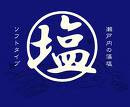
 Bodhisattva Jizoo wacht an den Sechs Wegen im Nachleben und seine Steinfiguren, entweder eine oder sechs, finden sich häufig am Wegrand. Die Salzhändler auf dem Weg nach Kamakura opferten diesem Jizo immer eine Priese Salz. Auf dem Rückweg war das Salz dann verschwunden und die Händler freuten sich, dass die Gottheit ihre Gabe angenommen hatten und versprachen sich davon Glück beim Salzhandel.
Bodhisattva Jizoo wacht an den Sechs Wegen im Nachleben und seine Steinfiguren, entweder eine oder sechs, finden sich häufig am Wegrand. Die Salzhändler auf dem Weg nach Kamakura opferten diesem Jizo immer eine Priese Salz. Auf dem Rückweg war das Salz dann verschwunden und die Händler freuten sich, dass die Gottheit ihre Gabe angenommen hatten und versprachen sich davon Glück beim Salzhandel.

